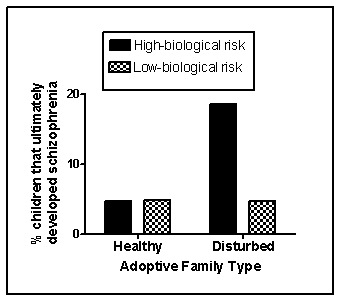Scenario II
The following scenario presents fabricated data consistent with the results of the following study:
Tienari, P., Wynne, L. C., Sorri, A., Lahti, I., Läksy, K., Moring, J., & ... Wahlberg, K. (2004) . Genotype-environment interaction in schizophrenia-spectrum disorder: Long-term follow-up study of Finnish adoptees. The British Journal of Psychiatry, 184(3) , 216-222. doi:10.1192/bjp.184.3.216
Schizophrenia affects approximately 1 percent of the general population and is characterized by the profound disruption of basic psychological processes; a distorted perception of reality;, altered or blunted emotional affect; and disturbances in thought, motivation, and behavior. The symptoms of schizophrenia are varied and are typically classified as either positive or negative. Positive symptoms of schizophrenia refer to thoughts and behaviors typically not observed in those without the disease, and can include things like delusions (patently false beliefs) , hallucinations (false perceptual experiences) , and disorganized speech. Negative symptoms of schizophrenia are deficits or disruptions in normal behaviors, such as social withdrawal. Cognitive deficits in executive functioning, attention span, and working memory also may be observed.
The symptoms of schizophrenia usually begin in late adolescence and the disease has a strong genetic component. Over the years, a number of biological factors have been linked to schizophrenia, although none alone adequately accounts for the disorder. One such example is the dopamine hypothesis, which states that schizophrenia is related to an excess in dopamine activity. Another theory points to enlarged brain ventricles and progressive cortex tissue loss as predictive of schizophrenia, although only a minority of persons with schizophrenia have enlarged ventricles, this structural anomaly can appear in those without the disease, and dopamine antagonists also may produce this effect.
Although research into the environmental determinants of schizophrenia has focused largely on the prenatal environment, psychological and social factors also contribute. Tienari et al. (2004) compared the risk of developing schizophrenia in children adopted into healthy versus disturbed families, the latter characterized by extreme conflict, volatile relationships, and communication deficits. Some of these children under investigation were identified as at-risk genetically for schizophrenia because their biological mothers were schizophrenic. The remainder was classified at low risk. The investigators utilized a longitudinal design and obtained the diagnostic status of the children with respect to schizophrenia when they reached young adulthood. Fabricated results consistent with this study are shown in Figure 15.2
Figure 15.2 
-(Scenario II) The fabricated results consistent with those obtained by Tienari et al. (2004) and shown in Figure 15.2 suggest that:
Definitions:
Identity
The fact of being who or what a person or thing is, often referring to aspects of self-concept and social representation.
Parents
The caregivers of a child, who may be biological or adoptive mothers and fathers, providing support, guidance, and resources for the child's development.
Peers
Individuals who are equal in age or position, often influencing behavior and social development.
Older Adults
Refers to individuals typically aged 65 years and older, often marked by increased healthcare needs and varying degrees of independence.
Q1: One criticism of the medical model of
Q4: Personality disorders are among the most criticized
Q18: The exercise of voluntary control over the
Q25: People come to understand one another through
Q70: The release of estrogen triggers a tend-and-befriend
Q81: Due to the unexpected nature of panic
Q87: Who is at greatest risk for burnout?<br>A)a
Q90: To become a practicing social worker, a
Q116: Michelle has a warm relationship with her
Q152: Sandra picked a fight with her boyfriend